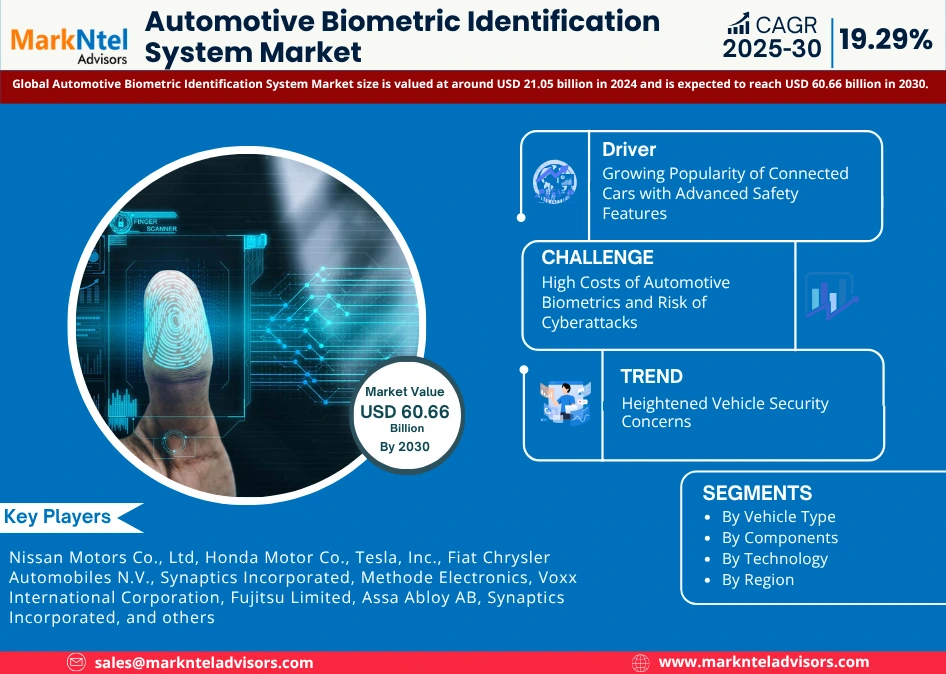
Global Automotive Biometric Identification System Market Research Report: Forecast (2025-2030)
Automotive Biometric Identification System Market - By Vehicle Type (Passenger Vehicle, Commercial Vehicle), By Components (Processing Units, Embedded Micro Computers, Micro Chipse...ts), By Behavioral Characteristics and Sensor Types (Microphone/Voice sensors, Signatures/Keystroke Sensors), By Physiological Characteristics & Sensor Types (Metal oxide Semiconductor/ Image Sensors, Optical/Fingerprint and Palm Sensors, Iris/Retinal Recognition Sensors), By Technology (Voice Recognition, Iris Recognition, Gesture Recognition, Multimodal Identification, Gesture Recognition, Fingerprint Recognition), By Region (North America, Latin America, Europe, Middle East & Africa, Asia-Pacific), By Company (Nissan Motors Co., Ltd, Honda Motor Co., Tesla, Inc., Fiat Chrysler Automobiles N.V., Synaptics Incorporated, Methode Electronics., Voxx International Corporation, Fujitsu Limited, Assa Abloy AB, Synaptics Incorporated) and others Read more
- Automotive
- May 2023
- Pages 208
- Report Format: PDF, Excel, PPT
Market Definition
Biometrics are used extensively in various applications across the automotive industry, including health monitoring, rationalization, vehicle immobilizer, ignition switch, & vehicle access control, among others, to start a vehicle using biometric scanners. Several automakers are integrating fingerprint technology into vehicles as the probability of finding two identical fingerprints is extremely less.
Market Insights & Analysis: Global Automotive Biometric Identification System Market (2025-30):
The Global Automotive Biometric Identification System Market size is valued at around USD 21.05 billion in 2024 and is expected to reach USD 60.66 billion in 2030. Along with this, the market is estimated to grow at a CAGR of around 19.29% during the forecast period, i.e., 2025-30.
| Report Coverage | Details |
|---|---|
| Historical Years | 2020–23 |
| Forecast Years | 2025–30 |
| Market Value in 2024 | USD 21.05 Billion |
| Market Value by 2030 | USD 60.66 Billion |
| CAGR (2025–30) | 19.29% |
| Leading Region | North America |
| Top Key Players | Nissan Motors Co., Ltd, Honda Motor Co., Tesla, Inc., Fiat Chrysler Automobiles N.V., Synaptics Incorporated, Methode Electronics, Voxx International Corporation, Fujitsu Limited, Assa Abloy AB, Synaptics Incorporated, and others |
| Segmentation | By Vehicle Type (Passenger Vehicle, Commercial Vehicle), By Components (Processing Units, Embedded Micro Computers, Micro Chipsets), By Behavioral Characteristics and Sensor Types (Microphone/Voice sensors, Signatures/Keystroke Sensors), By Physiological Characteristics & Sensor Types (Metal oxide Semiconductor/ Image Sensors, Optical/Fingerprint and Palm Sensors, Iris/Retinal Recognition Sensors), By Technology (Voice Recognition, Iris Recognition, Gesture Recognition, Multimodal Identification, Gesture Recognition, Fingerprint Recognition), By Region (North America, Latin America, Europe, Middle East & Africa, Asia-Pacific), By Company (Nissan Motors Co., Ltd, Honda Motor Co., Tesla, Inc., Fiat Chrysler Automobiles N.V., Synaptics Incorporated, Methode Electronics., Voxx International Corporation, Fujitsu Limited, Assa Abloy AB, Synaptics Incorporated) and others |
| Key Report Highlights |
|
*Boost strategic growth with in-depth market analysis - Get a free sample preview today!
Most of the market would be driven by the mounting demand for autonomous & connected vehicles, the ever-increasing inclusion of smartphone-enabled features in cars, and the burgeoning demand for data-driven services in vehicles. Worldwide, the massive surge in the sales of passenger cars in the last decade, and consequently, active efforts of automakers to enhance vehicle safety & security, are further projected to drive the market.
Biometric identification systems comprise high-end security elements that help prevent unauthorized access to driver & vehicle details. In the coming years, mainly mid-size cars are likely to exhibit biometric identification technology. More & more functionalities are being integrated into different vehicle models for enhanced user ease & security, owing to the growing consumer concerns over vehicle safety. Subsequently, the demand for automotive biometric identification systems is spurring at a prominent pace worldwide.
The industry participants have started offering different types of biometric identification systems comprising iris-based in-car cameras, hand gestures, face & fingerprint recognition scanners, voice recognition solutions, etc., with increased accuracy & reliability, mainly to assure reliability & quality. In addition, behavior-based software & algorithms are being integrated into biometric identification systems, which, in turn, shall stimulate the growth of the market in the coming years.

Global Automotive Biometric Identification System Market Driver:
Growing Popularity of Connected Cars with Advanced Safety Features – The ever-increased penetration of connected cars and the demand for self-driving autonomous cars to provide enhanced comfort & convenience to drivers are spurring the usage of advanced technologies like the IoT (Internet of Things), AI (Artificial Intelligence), & ML (Machine Learning), among others, and, consequently, augmenting the demand for biometric systems like facial, voice, fingerprint recognition, etc., for improved vehicle privacy & safety. Currently, the rising installation of these technologies as access control systems to start the vehicle through different biometric scanners is providing users with a more personalized experience and, in turn, driving the Global Automotive Biometric Identification System Market.
Global Automotive Biometric Identification System Market Challenge:
High Costs of Automotive Biometrics and Risk of Cyberattacks – One of the most prominent challenges for the global automotive biometric identification system market growth during 2025-30 is the high costs associated with the deployment of these technologies in the automotive sector, which restricts its adoption to only luxury vehicles. Another aspect likely to hinder the market expansion in the forecast period is the risk of cyberattacks associated with the use of connected devices in vehicles, which generates massive amounts of user data that can be manipulated by hackers.
Global Automotive Biometric Identification System Market Trend:
Heightened Vehicle Security Concerns – A key trend driving the growth of the global automotive biometric identification system market is the rising emphasis on vehicle security. As incidents of car theft and unauthorized access increase, automakers are turning to biometric technologies like fingerprint and facial recognition to provide robust, user-specific authentication. These systems make it far more difficult for unauthorized individuals to access or start a vehicle, offering enhanced protection compared to traditional keys or keyless entry. This growing focus on security is prompting widespread adoption of biometric solutions in both new vehicles and aftermarket upgrades.
Global Automotive Biometric Identification System Market (2025-30): Segmentation Analysis
The Global Automotive Biometric Identification System Market study of MarkNtel Advisors evaluates & highlights the major trends & influencing factors in each segment & includes predictions for the period 2025–2030 at the global level. Based on the analysis, the market has been further classified as:
Based on Vehicle Type:
- Passenger
- Commercial
Of both, passenger vehicles hold the maximum share of the Global Automotive Biometric Identification System Market. It ascribes to the rapidly increasing urbanization and the growing interest of consumers in private vehicle ownership owing to their improving living standards. Consequently, the burgeoning production & sales of vehicles worldwide and the mounting need for enhanced vehicle safety & security in them are augmenting the demand for biometric identification systems.
Several automotive OEMs are increasingly deploying innovative technologies to allow users for more personalization in vehicles and enhance vehicle accuracy. In addition, there's a growing penetration of luxury passenger cars equipped with high-end features like biometric vehicle access control. Hence, these aspects are spurring growth in the automotive biometric identification system market for passenger cars.
Based on Technology:
- Voice Recognition
- Fingerprint Recognition
- Iris Recognition
- Gesture Recognition
- Facial Identification
Here, fingerprint recognition holds the largest market share. Presently, it is the most extensively used biometrics in the automotive sector owing to the massive availability of this technology, its easy deployment, and lesser costs than other systems. In addition, the increasing integration of personalized features in vehicles and the rising penetration of connected cars & autonomous vehicles across both developed & developing countries are also driving the demand for fingerprint recognition in automobiles.
Fingerprint recognition is enabling automakers to enhance the driving experience and devise attractive & convenient ways to personalize the vehicle. The technology is being used as a security function and hence is considered a biological key for drivers to unlock & start cars without any hassle. These innovations are leading to the increasing integration of this technology into several luxury cars, thereby augmenting the overall growth of the Global Automotive Biometric Identification System Market.
Global Automotive Biometric Identification System Market (2025-30): Regional Projection
Geographically, the Global Automotive Biometric Identification System Market expands across:
- North America
- South America
- Middle East and Africa
- Asia-Pacific
- Europe
Of all regions globally, North America is projected to acquire a significant share of the Automotive Biometrics Identification Systems Market during 2025-30. It owes to the growing adoption of technologically advanced products and the mounting demand for luxury & autonomous vehicles across the region. Across North America, the US is the leading market in terms of acceptance & advancement of automotive biometrics technology, and the country is projected to maintain its market dominance due to a sizable consumer base that holds multiple vehicles and the extensive presence of leading industry participants. In addition, growing user concerns over driver authentication owing to rapidly rising vehicle thefts across North America are also promoting the adoption of biometric identification systems in the region.
Regional automakers are increasingly adopting newer technologies, including biometrics, in order to create additional value & market differentiation. Several companies have already started integrating biometric technology into their high-end luxury vehicles equipped with superior security features, including ignition switch, vehicular access, rationalization, vehicle immobilizer, as well as health monitoring. Hence, these aspects are set to create lucrative prospects for the North America Automotive Biometrics Identification Systems Market through 2030.
Global Automotive Biometric Identification System Industry Recent Development:
- 2024: Tesla, Inc. received approval from Chinese authorities for two models concerning privacy and data protection compliance, indicating advancements in handling biometric data within their vehicles.
Gain a Competitive Edge with Our Global Automotive Biometric Identification System Market Report
- Global Automotive Biometric Identification System Market Report by MarkNtel Advisors provides a detailed & thorough analysis of market size & share, growth rate, competitive landscape, and key players. This comprehensive analysis helps businesses gain a holistic understanding of the market dynamics & make informed decisions.
- This report also highlights current market trends & future projections, allowing businesses to identify emerging opportunities & potential challenges. By understanding market forecasts, companies can align their strategies & stay ahead of the competition.
- Global Automotive Biometric Identification System Market Report aids in assessing & mitigating risks associated with entering or operating in the market. By understanding market dynamics, regulatory frameworks, and potential challenges, businesses can develop strategies to minimize risks & optimize their operations.
*Reports Delivery Format - Market research studies from MarkNtel Advisors are offered in PDF, Excel and PowerPoint formats. Within 24 hours of the payment being successfully received, the report will be sent to your email address.
Frequently Asked Questions
- Introduction
- Product Definition
- Research Process
- Assumptions
- Market Segmentation
- Executive Summary
- Expert Verbatim- What our Experts Say?
- Global Automotive Biometric Identification System Market Analysis, 2020-2030F
- Market Size & Analysis
- Market Revenue
- Market Share & Analysis
- By Vehicle Type
- Passenger Vehicle
- Commercial Vehicle
- By Components
- Processing Units
- Embedded Micro Computers
- Micro Chipsets
- By Behavioral Characteristics and Sensor Types
- Microphone/Voice sensors
- Signatures/Keystroke Sensors
- By Physiological Characteristics & Sensor Types
- Metal oxide Semiconductor/ Image Sensors
- Optical/Fingerprint and Palm Sensors
- Iris/Retinal Recognition Sensors
- By Technology
- Voice Recognition
- Iris Recognition
- Gesture Recognition
- Multimodal Identification
- Gesture Recognition
- Fingerprint Recognition
- By Region
- North America
- Latin America
- Europe
- Middle East & Africa
- Asia-Pacific
- By Company
- By Vehicle Type
- Market Size & Analysis
- North America Automotive Biometric Identification System Market Analysis, 2020-2030F
- Market Size & Analysis
- Market Revenue
- Market Share & Analysis
- By Vehicle Type
- By Components
- By Behavioral Characteristics & Sensor Types
- By Physiological Characteristics & Sensor Types
- By Technology
- By Country
- United states
- Canada
- United States Automotive Biometric Identification System Market Analysis, 2020-2030F
- Market Size & Analysis
- Market Revenue
- Market Share & Analysis
- By Vehicle Type
- By Components
- By Behavioral Characteristics & Sensor Types
- By Physiological Characteristics & Sensor Types
- By Technology
- Market Size & Analysis
- Canada Automotive Biometric Identification System Market Analysis, 2020-2030F
- Market Size & Analysis
- Market Revenue
- Market Share & Analysis
- By Vehicle Type
- By Components
- By Behavioral Characteristics & Sensor Types
- By Physiological Characteristics & Sensor Types
- By Technology
- Market Size & Analysis
- Market Size & Analysis
- Latin America Automotive Biometric Identification System Market Analysis, 2020-2030F
- Market Size & Analysis
- Market Revenue
- Market Share & Analysis
- By Vehicle Type
- By Components
- By Behavioral Characteristics & Sensor Types
- By Physiological Characteristics & Sensor Types
- By Technology
- By Country
- Mexico
- Brazil
- Brazil Automotive Biometric Identification System Market Analysis, 2020-2030F
- Market Size & Analysis
- Market Revenue
- Market Share & Analysis
- By Vehicle Type
- By Components
- By Behavioral Characteristics & Sensor Types
- By Physiological Characteristics & Sensor Types
- By Technology
- Market Size & Analysis
- Mexico Automotive Biometric Identification System Market Analysis, 2020-2030F
- Market Size & Analysis
- Market Revenue
- Market Share & Analysis
- By Vehicle Type
- By Components
- By Behavioral Characteristics & Sensor Types
- By Physiological Characteristics & Sensor Types
- By Technology
- Market Size & Analysis
- Market Size & Analysis
- Europe Automotive Biometric Identification System Market Analysis, 2020-2030F
- Market Size & Analysis
- Market Revenue
- Market Share & Analysis
- By Vehicle Type
- By Components
- By Behavioral Characteristics & Sensor Types
- By Physiological Characteristics & Sensor Types
- By Technology
- By Country
- Germany
- Italy
- Russia
- Spain
- United Kingdom
- Germany Automotive Biometric Identification System Market Analysis, 2020-2030F
- Market Size & Analysis
- Market Revenue
- Market Share & Analysis
- By Vehicle Type
- By Components
- By Behavioral Characteristics & Sensor Types
- By Physiological Characteristics & Sensor Types
- By Technology
- Market Size & Analysis
- Italy Automotive Biometric Identification System Market Analysis, 2020-2030F
- Market Size & Analysis
- Market Revenue
- Market Share & Analysis
- By Vehicle Type
- By Components
- By Behavioral Characteristics & Sensor Types
- By Physiological Characteristics & Sensor Types
- By Technology
- Market Size & Analysis
- Spain Automotive Biometric Identification System Market Analysis, 2020-2030F
- Market Size & Analysis
- Market Revenue
- Market Share & Analysis
- By Vehicle Type
- By Components
- By Behavioral Characteristics & Sensor Types
- By Physiological Characteristics & Sensor Types
- By Technology
- Market Size & Analysis
- Russia Automotive Biometric Identification System Market Analysis, 2020-2030F
- Market Size & Analysis
- Market Revenue
- Market Share & Analysis
- By Vehicle Type
- By Components
- By Behavioral Characteristics & Sensor Types
- By Physiological Characteristics & Sensor Types
- By Technology
- Market Size & Analysis
- United Kingdom Automotive Biometric Identification System Market Analysis, 2020-2030F
- Market Size & Analysis
- Market Revenue
- Market Share & Analysis
- By Vehicle Type
- By Components
- By Behavioral Characteristics & Sensor Types
- By Physiological Characteristics & Sensor Types
- By Technology
- Market Size & Analysis
- Market Size & Analysis
- Middle East & Africa Automotive Biometric Identification System Market Analysis, 2020-2030F
- Market Size & Analysis
- Market Revenue
- Market Share & Analysis
- By Vehicle Type
- By Components
- By Behavioral Characteristics & Sensor Types
- By Physiological Characteristics & Sensor Types
- By Technology
- By Country
- UAE
- Iran
- Israel
- Saudi Arabia
- UAE Automotive Biometric Identification System Market Analysis, 2020-2030F
- Market Size & Analysis
- Market Revenue
- Market Share & Analysis
- By Vehicle Type
- By Components
- By Behavioral Characteristics & Sensor Types
- By Physiological Characteristics & Sensor Types
- By Technology
- Market Size & Analysis
- Saudi Arabia Automotive Biometric Identification System Market Analysis, 2020-2030F
- Market Size & Analysis
- Market Revenue
- Market Share & Analysis
- By Vehicle Type
- By Components
- By Behavioral Characteristics & Sensor Types
- By Physiological Characteristics & Sensor Types
- By Technology
- Market Size & Analysis
- Israel Automotive Biometric Identification System Market Analysis, 2020-2030F
- Market Size & Analysis
- Market Revenue
- Market Share & Analysis
- By Vehicle Type
- By Components
- By Behavioral Characteristics & Sensor Types
- By Physiological Characteristics & Sensor Types
- By Technology
- Market Size & Analysis
- Iran Automotive Biometric Identification System Market Analysis, 2020-2030F
- Market Size & Analysis
- Market Revenue
- Market Share & Analysis
- By Vehicle Type
- By Components
- By Behavioral Characteristics & Sensor Types
- By Physiological Characteristics & Sensor Types
- By Technology
- Market Size & Analysis
- South Africa Automotive Biometric Identification System Market Analysis, 2020-2030F
- Market Size & Analysis
- Market Revenue
- Market Share & Analysis
- By Vehicle Type
- By Components
- By Behavioral Characteristics & Sensor Types
- By Physiological Characteristics & Sensor Types
- By Technology
- Market Size & Analysis
- Market Size & Analysis
- Asia-Pacific Automotive Biometric Identification System Market Analysis, 2020-2030F
- Market Size & Analysis
- Market Revenue
- Market Share & Analysis
- By Vehicle Type
- By Components
- By Behavioral Characteristics & Sensor Types
- By Physiological Characteristics & Sensor Types
- By Technology
- By Country
- China
- India
- Japan
- South Korea
- Indonesia
- Thailand
- Malaysia
- China Automotive Biometric Identification System Market Analysis, 2020-2030F
- Market Size & Analysis
- Market Revenue
- Market Share & Analysis
- By Vehicle Type
- By Components
- By Behavioral Characteristics & Sensor Types
- By Physiological Characteristics & Sensor Types
- By Technology
- Market Size & Analysis
- India Automotive Biometric Identification System Market Analysis, 2020-2030F
- Market Size & Analysis
- Market Revenue
- Market Share & Analysis
- By Vehicle Type
- By Components
- By Behavioral Characteristics & Sensor Types
- By Physiological Characteristics & Sensor Types
- By Technology
- Market Size & Analysis
- Japan Automotive Biometric Identification System Market Analysis, 2020-2030F
- Market Size & Analysis
- Market Revenue
- Market Share & Analysis
- By Vehicle Type
- By Components
- By Behavioral Characteristics & Sensor Types
- By Physiological Characteristics & Sensor Types
- By Technology
- Market Size & Analysis
- South Korea Automotive Biometric Identification System Market Analysis, 2020-2030F
- Market Size & Analysis
- Market Revenue
- Market Share & Analysis
- By Vehicle Type
- By Components
- By Behavioral Characteristics & Sensor Types
- By Physiological Characteristics & Sensor Types
- By Technology
- Market Size & Analysis
- Indonesia Automotive Biometric Identification System Market Analysis, 2020-2030F
- Market Size & Analysis
- Market Revenue
- Market Share & Analysis
- By Vehicle Type
- By Components
- By Behavioral Characteristics & Sensor Types
- By Physiological Characteristics & Sensor Types
- By Technology
- Market Size & Analysis
- Thailand Automotive Biometric Identification System Market Analysis, 2020-2030F
- Market Size & Analysis
- Market Revenue
- Market Share & Analysis
- By Vehicle Type
- By Components
- By Behavioral Characteristics & Sensor Types
- By Physiological Characteristics & Sensor Types
- By Technology
- Market Size & Analysis
- Malaysia Automotive Biometric Identification System Market Analysis, 2020-2030F
- Market Size & Analysis
- Market Revenue
- Market Share & Analysis
- By Vehicle Type
- By Components
- By Behavioral Characteristics & Sensor Types
- By Physiological Characteristics & Sensor Types
- By Technology
- Market Size & Analysis
- Market Size & Analysis
- Global Automotive Biometric Identification System Market Policies, Regulations, Product Standards
- Global Automotive Biometric Identification System Market Trends & Insights
- Global Automotive Biometric Identification System Market Dynamics
- Growth Drivers
- Challenges
- Impact Analysis
- Global Automotive Biometric Identification System Market Hotspot & Opportunities
- Global Automotive Biometric Identification System Market Key Strategic Imperatives for Success & Growth
- Competition Outlook
- Competition Matrix
- Product Portfolio
- Brand Specialization
- Target Markets
- Target End Users
- Research & Development
- Strategic Alliances
- Strategic Initiatives
- Company Profiles (Business Description, Product Segments, Business Segments, Financials, Strategic Alliances/ Partnerships, Future Plans)
- Nissan Motors Co., Ltd
- Honda Motor Co.
- Tesla, Inc.
- Fiat Chrysler Automobiles N.V.
- Synaptics Incorporated
- Methode Electronics.
- Voxx International Corporation
- Fujitsu Limited
- Assa Abloy AB
- Synaptics Incorporated
- Competition Matrix
- Disclaimer
MarkNtel Advisors follows a robust and iterative research methodology designed to ensure maximum accuracy and minimize deviation in market estimates and forecasts. Our approach combines both bottom-up and top-down techniques to effectively segment and quantify various aspects of the market. A consistent feature across all our research reports is data triangulation, which examines the market from three distinct perspectives to validate findings. Key components of our research process include:
1. Scope & Research Design At the outset, MarkNtel Advisors define the research objectives and formulate pertinent questions. This phase involves determining the type of research—qualitative or quantitative—and designing a methodology that outlines data collection methods, target demographics, and analytical tools. They also establish timelines and budgets to ensure the research aligns with client goals.
2. Sample Selection and Data Collection In this stage, the firm identifies the target audience and determines the appropriate sample size to ensure representativeness. They employ various sampling methods, such as random or stratified sampling, based on the research objectives. Data collection is carried out using tools like surveys, interviews, and observations, ensuring the gathered data is reliable and relevant.
3. Data Analysis and Validation Once data is collected, MarkNtel Advisors undertake a rigorous analysis process. This includes cleaning the data to remove inconsistencies, employing statistical software for quantitative analysis, and thematic analysis for qualitative data. Validation steps are taken to ensure the accuracy and reliability of the findings, minimizing biases and errors.

4. Data Forecast and FinalizationThe final phase involves forecasting future market trends based on the analyzed data. MarkNtel Advisors utilize predictive modeling and time series analysis to anticipate market behaviors. The insights are then compiled into comprehensive reports, featuring visual aids like charts and graphs, and include strategic recommendations to inform client decision-making









